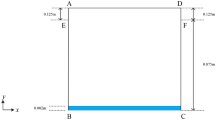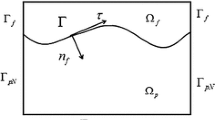Abstract
The incompressible material point method was proposed for modeling the free surface flow problems based on the operator splitting technique which decouples the solution of the velocity and the pressure in our previous work. To further model the coupling problems between the incompressible fluid and the moving irregular solid bodies, an augmented incompressible material point method is proposed in this paper based on the energy minimization form of operator splitting technique. The interaction between the fluid and the solid is taken into account via the work done by the fluid pressure on the solid bodies. By minimizing the total work done by the fluid pressure, volume-weighted pressure Poisson equations are obtained. The proposed method is validated with liquid sloshing in a rectangular tank subjected to various base-excitations, and is then used to study the optimal height of baffles mounted on the bottom of the tank to mitigate the sloshing wave.


















Similar content being viewed by others
References
Batty, C., Bertails, F., Bridson, R.: A fast variational framework for accurate solid-fluid coupling. In: ACM Transactions on Graphics (TOG), vol. 26, p. 100. ACM (2007)
Burghardt, J., Leavy, B., Guilkey, J., Xue, Z., Brannon, R.: Application of Uintah-MPM to shaped charge jet penetration of aluminum. In: IOP Conference Series: Materials Science and Engineering, vol. 10, p. 012223. IOP Publishing (2010)
Calderer, R., Zhu, L., Gibson, R., Masud, A.: Residual-based turbulence models and arbitrary Lagrangian–Eulerian framework for free surface flows. Math. Model. Methods Appl Sci. 25(12), 2287–2317 (2015)
Chen, B.F., Nokes, R.: Time-independent finite difference analysis of fully non-linear and viscous fluid sloshing in a rectangular tank. J. Comput. Phys. 209(1), 47–81 (2005)
Chen, J., Beraun, J.: A generalized smoothed particle hydrodynamics method for nonlinear dynamic problems. Comput. Methods Appl. Mech. Eng. 190(1), 225–239 (2000)
Chen, Z., Hu, W., Shen, L.M., Xin, X., Brannon, R.: An evaluation of the MPM for simulating dynamic failure with damage diffusion. Eng. Fract. Mech. 69, 1873–1890 (2002)
Chen, Z., Zong, Z., Li, H., Li, J.: An investigation into the pressure on solid walls in 2D sloshing using SPH method. Ocean Eng. 59, 129–141 (2013)
Chen, Z., Zong, Z., Liu, M.B., Li, H.T.: A comparative study of truly incompressible and weakly compressible SPH methods for free surface incompressible flows. Int. J. Numer. Methods Fluids 73(9), 813–829 (2013)
Chen, Z.P., Qiu, X.M., Zhang, X., Lian, Y.P.: Improved coupling of finite element method with material point method based on a particle-to-surface contact algorithm. Comput. Methods Appl. Mech. Eng. 293(15), 1–19 (2015)
Chorin, A.J.: Numerical solution of the Navier-Stokes equations. Math. Comput. 22(104), 745–762 (1968)
Colin, F., Egli, R., Lin, F.Y.: Computing a null divergence velocity field using smoothed particle hydrodynamics. J. Comput. Phys. 217(2), 680–692 (2006)
Cummins, S.J., Rudman, M.: An SPH projection method. J. Comput. Phys. 152(2), 584–607 (1999)
Faltinsen, O.M.: A numerical nonlinear method of sloshing in tanks with two-dimensional flow. J. Ship Res. 22(3), 193–202 (1978)
Faltinsen, O.M., Rognebakke, O.F., Lukovsky, I.A., Timokha, A.N.: Multidimensional modal analysis of nonlinear sloshing in a rectangular tank with finite water depth. J. Fluid Mech. 407, 201–234 (2000)
Faltinsen, O.M., Timokha, A.N.: Sloshing, pp. 125–126 (2009)
Fang, J., Parriaux, A.: A regularized lagrangian finite point method for the simulation of incompressible viscous flows. J. Comput. Phys. 227(20), 8894–8908 (2008)
Foster, N., Fedkiw, R.: Practical animation of liquids. In: Proceedings of the 28th Annual Conference on Computer Graphics and Interactive Techniques, pp. 23–30. ACM (2001)
Gilabert, F.A., Cantavella, V.C., Sanchez, E., Mallol, G.: Modelling fracture process in ceramic materials using the Material Point Method. Eur. Phys. Lett. 96, 24002 (2011)
Gong, K., Shao, S., Liu, H., Wang, B., Tan, S.K.: Two-phase sph simulation of fluid-structure interactions. J. Fluids Struct. 65, 155–179 (2016)
Goudarzi, M.A., Sabbagh-Yazdi, S.R.: Investigation of nonlinear sloshing effects in seismically excited tanks. Soil Dyn. Earthq. Eng. 43, 355–365 (2012)
Gui, Q., Dong, P., Shao, S.: Numerical study of ppe source term errors in the incompressible sph models. Int. J. Numer. Meth. Fluids 77(6), 358–379 (2015)
Harlow, F.H., Welch, J.E.: Numerical calculation of time-dependent viscous incompressible flow of fluid with a free surface. Phys. Fluids 8, 2182–2189 (1965)
Hirt, C.W., Nichols, B.D.: Volume of fluid (VOF) method for the dynamics of free boundaries. J. Comput. Phys. 39(1), 201–225 (1981)
Huang, P., Zhang, X., Ma, S.: Shared memory OpenMP parallelization of explicit mpm and its application to hypervelocity impact. CMES Comput. Model. Eng. Sci. 38, 119–147 (2008)
Huang, P., Zhang, X., Ma, S., Huang, X.: Contact algorithms for the material point method in impact and penetration simulation. Int. J. Numer. Methods Eng. 85(4), 498–517 (2011)
Hughes, T.J., Liu, W.K., Zimmermann, T.K.: Lagrangian-eulerian finite element formulation for incompressible viscous flows. Comput. Methods Appl. Mech. Eng. 29(3), 329–349 (1981)
Ihmsen, M., Cornelis, J., Solenthaler, B., Horvath, C., Teschner, M.: Implicit incompressible SPH. IEEE Trans. Vis. Comput. Graph. 20(3), 426–435 (2014)
Kolaei, A., Rakheja, S., Richard, M.J.: A coupled multimodal and boundary-element method for analysis of anti-slosh effectiveness of partial baffles in a partly-filled container. Comput. Fluids 107, 43–58 (2015)
Komatsu, K.: Non-linear sloshing analysis of liquid in tanks with arbitrary geometries. Int. J. Non-linear Mech. 22(3), 193–207 (1987)
Koshizuka, S., Oka, Y.: Moving-particle semi-implicit method for fragmentation of incompressible fluid. Nucl. Sci. Eng. 123(3), 421–434 (1996)
Lee, E.S., Moulinec, C., Xu, R., Violeau, D., Laurence, D., Stansby, P.: Comparisons of weakly compressible and truly incompressible algorithms for the SPH mesh free particle method. J. Comput. Phys. 227(18), 8417–8436 (2008)
Li, J.G., Hamamoto, Y., Liu, Y., Zhang, X.: Sloshing impact simulation with material point method and its experimental validations. Comput. Fluids 103, 86–99 (2014)
Lian, Y.P., Liu, Y., Zhang, X.: Coupling of membrane element with material point method for fluid-membrane interaction problems. Int. J. Mech. Mater. Des. 10(2), 199–211 (2014)
Lian, Y.P., Zhang, X., Zhang, F., Cui, X.X.: Tied interface grid material point method for problems with localized extreme deformation. Int. J. Impact Eng. 70, 50–61 (2014)
Lian, Y.P., Zhang, X., Zhou, X., Ma, Z.T.: A FEMP method and its application in modeling dynamic response of reinforced concrete subjected to impact loading. Comput. Methods Appl. Mech. Eng. 200(17–20), 1659–1670 (2011)
Liu, M., Shao, J., Chang, J.: On the treatment of solid boundary in smoothed particle hydrodynamics. Sci. China Technol. Sci. 55(1), 244–254 (2012)
Liu, P., Liu, Y., Zhang, X.: Internal-structure-model based simulation research of shielding properties of honeycomb sandwich panel subjected to high-velocity impact. Int. J. Impact Eng. 77, 120–133 (2015)
Liu, P., Liu, Y., Zhang, X.: Simulation of hyper-velocity impact on double honeycomb sandwich panel and its staggered improvement with internal-structure model. Int. J. Mech. Mater. Des. 12(2), 241–254 (2016)
Ma, S., Zhang, X., Lian, Y.P., Zhou, X.: Simulation of high explosive explosion using adaptive material point method. CMES Comput. Model. Eng. Sci. 39(2), 101–123 (2009)
Ma, S., Zhang, X., Qiu, X.M.: Comparison study of MPM and SPH in modeling hypervelocity impact problems. Int. J. Impact Eng. 36, 272–282 (2009)
Ma, Z., Zhang, X., Huang, P.: An object-oriented MPM framework for simulation of large deformation and contact of numerous grains. CMES Comput. Model. Eng. Sci. 55(1), 61–87 (2010)
Mast, C.M., Mackenzie-Helnwein, P., Arduino, P., Miller, G.R., Shin, W.: Mitigating kinematic locking in the material point method. J. Comput. Phys. 231(16), 5351–5373 (2012)
Miles, J.W.: Resonantly forced surface waves in a circular cylinder. J. Fluid Mech. 149, 15–31 (1984)
Monaghan, J.J.: Simulating free surface flows with SPH. J. Comput. Phys. 110(2), 399–406 (1994)
Morris, J.P., Fox, P.J., Zhu, Y.: Modeling low Reynolds number incompressible flows using SPH. J. Comput. Phys. 136(1), 214–226 (1997)
Nairn, J.A.: Numerical implementation of imperfect interfaces. Comput. Mater. Sci. 40, 525–536 (2007)
Nakayama, T., Washizu, K.: The boundary element method applied to the analysis of two-dimensional nonlinear sloshing problems. Int. J. Numer. Methods Eng. 17(11), 1631–1646 (1981)
Okamoto, T., Kawahara, M.: Two-dimensional sloshing analysis by lagrangian finite element method. Int. J. Numer. Methods Fluids 11(5), 453–477 (1990)
Onate, E.: A finite point method in computational mechanics. Int. J. Numer. Methods Eng. 39, 3839–3866 (1996)
Shao, S., Lo, E.Y.: Incompressible sph method for simulating newtonian and non-newtonian flows with a free surface. Adv. Water Resour. 26(7), 787–800 (2003)
Shu, C.W., Osher, S.: Efficient implementation of essentially non-oscillatory shock-capturing schemes. J. Comput. Phys. 77(2), 439–471 (1988)
Sulsky, D., Chen, Z., Schreyer, H.L.: A particle method for history-dependent materials. Comput. Methods Appl. Mech. Eng. 118(1–2), 179–196 (1994)
Tan, H.L., Nairn, J.A.: Hierarchical, adaptive, material point method for dynamic energy release rate calculations. Comput. Methods Appl. Mech. Eng. 191(19–20), 2095–2109 (2002)
Tang, B., Li, J., Wang, T.: The least square particle finite element method for simulating large amplitude sloshing flows. Acta Mech. Sin. 24(3), 317–323 (2008)
Tran, L.T., Kim, J., Berzins, M.: Solving time-dependent PDEs using the material point method, a case study from gas dynamics. Int. J. Numer. Methods Fluids 62(7), 709–732 (2010)
Wu, C.H., Faltinsen, O.M., Chen, B.F.: Numerical study of sloshing liquid in tanks with baffles by time-independent finite difference and fictitious cell method. Comput. Fluids 63, 9–26 (2012)
Yang, X., Liu, M., Peng, S.: Smoothed particle hydrodynamics modeling of viscous liquid drop without tensile instability. Comput. Fluids 92, 199–208 (2014)
York, A.R., Sulsky, D., Schreyer, H.L.: Fluid-membrane interaction based on the material point method. Int. J. Numer. Methods Eng. 48, 901–924 (2000)
Zhang, F., Zhang, X., Sze, K.Y., Lian, Y., Liu, Y.: Incompressible material point method for free surface flow. J. Comput. Phys. 330, 92–110 (2017)
Zhang, X., Chen, Z., Liu, Y.: The Material Point Method - A Continuum-Based Particle Method for Extreme Loading Cases. Academic Press, London (2016)
Zhu, Y.N., Bridson, R.: Animating sand as a fluid. ACM Trans. Graph. (TOG) 24(3), 965–972 (2005)
Acknowledgements
This work was supported by the National Natural Science Foundation of China (Grant No. 11272180).
Author information
Authors and Affiliations
Corresponding author
Rights and permissions
About this article
Cite this article
Zhang, F., Zhang, X. & Liu, Y. An augmented incompressible material point method for modeling liquid sloshing problems. Int J Mech Mater Des 14, 141–155 (2018). https://doi.org/10.1007/s10999-017-9366-5
Received:
Accepted:
Published:
Issue Date:
DOI: https://doi.org/10.1007/s10999-017-9366-5




